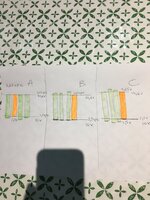andy63
Free Member
Hi I'm just going to describe a recent issue I've had and see what anyones thoughts on it are.. be much appreciated 
Visited the van after a 7/8 week lay up in storage..
I have 280w solar through an mppt controler.. two of the above batteries in parallel... a Stirling 60 amp battery to battery and a dedicated lifepo4 20 amp mains charger..
The only load on the leisure would have been a Stirling battery master device keeping the start battery topped.. and the solar connected to the leisure batteries..
The growler alarm was active and whatever other small loads are associated with the vehicle electronics..
So when I checked it the leisure batteries were reading 12.5 volts.. the start battery 11.7v.. the engine just started and I watched to see what the battery to battery would deliver..
My solar appeared to be supplying nothing.. I put that down to the conditions but later found a dodgy fuse connection to be the likely cause.. and possibly why the battery voltage had dropped so low..
It's been sat 4/weeks before with no issues..
The voltage rose to 14.5v from the btb charger but no current flow....
Took it for a drive about half hour and still no change to those readings so I connected a generator to the hook up and switched on the mains charger..again voltage rose to 14.4v but no current flow....
The following day I got the van home and removed the batteries..
With a multimeter they each had 12.7 v on the terminals..
I tried a victron charger on each one but again it's as if the charger was seeing full batteries.. Good voltage but no current flow into the batteries..
I briefly tried a small load on each battery and it was still supplying current ..I didnt want to load them to much till I could see what was going on..
So..the batteries hadn't shut down but wouldn't accept a charge..
Anybody offer an explanation..
Andy
Visited the van after a 7/8 week lay up in storage..
I have 280w solar through an mppt controler.. two of the above batteries in parallel... a Stirling 60 amp battery to battery and a dedicated lifepo4 20 amp mains charger..
The only load on the leisure would have been a Stirling battery master device keeping the start battery topped.. and the solar connected to the leisure batteries..
The growler alarm was active and whatever other small loads are associated with the vehicle electronics..
So when I checked it the leisure batteries were reading 12.5 volts.. the start battery 11.7v.. the engine just started and I watched to see what the battery to battery would deliver..
My solar appeared to be supplying nothing.. I put that down to the conditions but later found a dodgy fuse connection to be the likely cause.. and possibly why the battery voltage had dropped so low..
It's been sat 4/weeks before with no issues..
The voltage rose to 14.5v from the btb charger but no current flow....
Took it for a drive about half hour and still no change to those readings so I connected a generator to the hook up and switched on the mains charger..again voltage rose to 14.4v but no current flow....
The following day I got the van home and removed the batteries..
With a multimeter they each had 12.7 v on the terminals..
I tried a victron charger on each one but again it's as if the charger was seeing full batteries.. Good voltage but no current flow into the batteries..
I briefly tried a small load on each battery and it was still supplying current ..I didnt want to load them to much till I could see what was going on..
So..the batteries hadn't shut down but wouldn't accept a charge..
Anybody offer an explanation..
Andy

